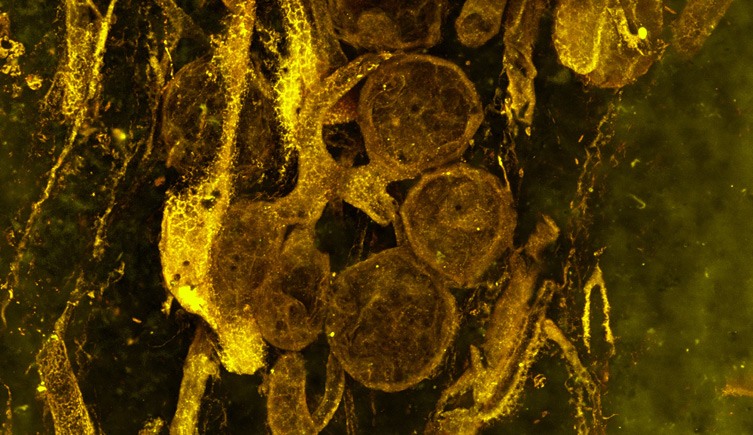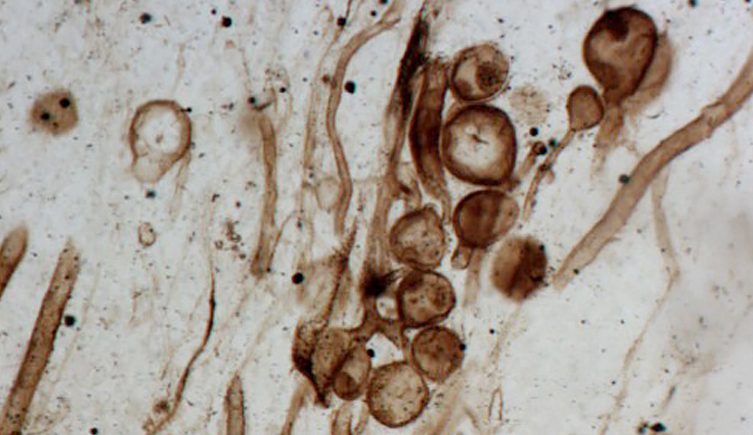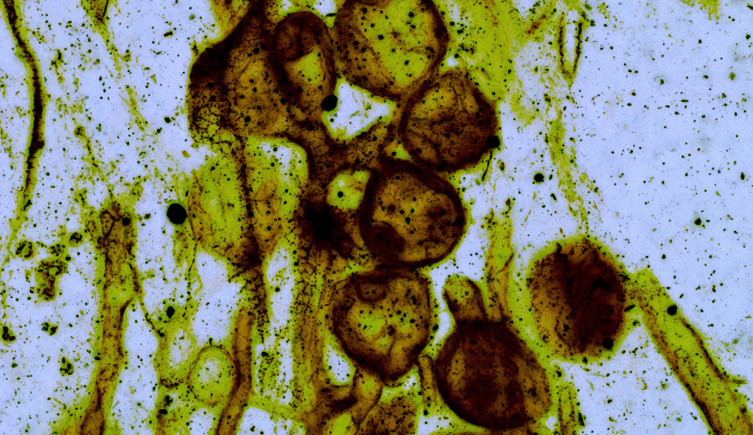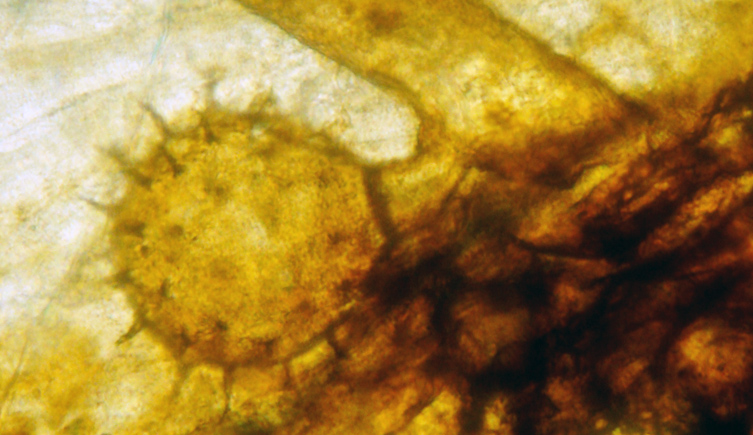
Fly agaric, Amanita muscaria, in woodland leaf litter. This fungus often forms mutualistic symbiosis with species of birch and pine.
Principal Investigator
Project summary
- Focus: Investigating the origin and evolution of fungal-plant relationships
We are using fossils to investigate the origin and evolution of relationships between plants and microorganisms during the early development of life on land.
Our research objectives are to:
- complete a systematic survey of microscopic eukaryotes based on the Museum's fossil slide collections
- describe new microfossils using state-of-the-art imaging techniques
- determine their affinities using modern phylogenetic methods

Fungal colonisation in the fossil plant Asteroxylon mackiei. Transverse section of an aerial axis.
Fungi and fungi-like eukaryotes are ancient groups thought to be vital in the early development of terrestrial ecosystems. Molecular phylogenetic studies of living species reveal their evolutionary history, but scientists also use fossils to calibrate these relationships.
Fossils provide the only direct evidence of early fungi and fungi-like microorganisms interacting with plants. Fossils are therefore crucial in defining evolutionary relationships of modern species, as they allow us to determine the beginnings of lineages.
Our research
We are collecting new data on fossil fungi and fungus-like microorganisms using:
- microscopy
- state-of-the-art imaging methods
- phylogenetic characters for the newly described microorganisms, to develop a phylogenetic framework that relates to modern forms.
This project is improving our understanding of the origin and evolution of key microorganism and plant associations.
Symbiosis
- Fungi: Fungi are heterotrophic eukaryotes. They are one of the least explored biodiversity resources and their symbiotic relations are crucial to the survival of plants.
- Fungi-like microorganisms: The Oomycetes (fungi-like microorganisms) are some of the most important plant pathogens, including Potato Blight Phytophthora infestans and Ash dieback Chalara fraxinea. Although they superficially resemble fungi in mycelial growth and mode of nutrition, they show distinct characteristics. Recent research on fossils in the Museum's collection has provided the earliest evidence for parasitism in this group.
Find out more about the earliest evidence for parasitism in Oomycetes.

407 million-year-old fungal spores in the Rhynie chert, Scotland
Survey
We are undertaking the Museum's first systematic study of microscopic symbionts preserved among plant tissues, based on observations of the thin section collection.
The soft tissues of fossil plants are often preserved in minerals, such as pyrite, calcite and silica. Thin sections reveal the internal structure of these specimens and contain valuable information about microscopic symbionts preserved inside.
The Museum has a large and comprehensive collection of fossil plants and a unique collection of thin sections containing over 15,000 objects.
Find out more about the palaeobotany collections.
We are sampling plant taxonomic groups for all key organ systems - roots, stems, trunks, leaves and reproductive organs.
Data is sourced from two important time slices:
- The Early Devonian Rhynie Chert, ca 410 million years old. This is the oldest terrestrial site of exceptional preservation. Plants preserved in these rocks are all small and herbaceous.
- The Late Carboniferous Coal Measures of the UK, ca 310 million years old. Terrestrial ecosystems were well established in forested wetlands during this period.
Imaging processes
We are using three different light microscopy imaging processes to describe fungal structures, identify new forms and characterise their relationships with plants.
-

Confocal laser scanning microscopy allows us to obtain very fine (small) details and 3D representations of the microorganisms.
-

Standard and high resolution microscopes image crucial aspects of morphology.
-

Our microscopes are equipped with special software to enhance depth of field.
-

310 million-year-old fossil oomycete, Combresomyces williamsonii within the stem of a fossil plant.
Phylogenetics
Newly-described species are classified based on their evolutionary development. This phylogenetic approach allows us to place organisms into a framework that can be compared to modern forms.

Phylogenetic relationships among the main orders within the Oomycetes, based on molecular sequence data (modified after Beakes and Sekimoto, 2009)
Strullu-Derrien et al. 2011.
Museum staff
- Dr Christine Strullu-Derrien
- Dr Paul Kenrick
- Dr Silvia Pressel
- Dr Jeffrey Duckett
- Dr Tomasz Goral
Other Collaborators
- Prof Nigel Trewin
University of Aberdeen
- Dr Alain Le Hérissé
University of Western Brittany - Dr Jean-Philippe Rioult
University of Caen Normandy
Related information
Publications
- Krings M, Taylor TN, Dotzler N (2011) The fossil record of the Peronosporomycota (Oomycota). Mycologia, 103(3): 445-457.
- Strullu-Derrien C, Kenrick P, Rioult JP, Strullu DG (2011) Evidence of parasitic Oomycetes (Peronosporomycetes) infecting the stem cortex of the Carboniferous seed fern Lyginopteris oldhamia. Proceedings of the Royal Society B, 278: 675-680.
- Strullu-Derrien C, Rioult JP, Strullu DG (2009) Mycorrhizas in Upper Carboniferous Radiculites-type Cordaitalean rootlets. New Phytologist, 182: 561-564.
- Remy W, Taylor TN, Hass H, Kerp H (1994) Four hundred-million-year-old vesicular arbuscular mycorrhizae. Proceedings of the National Academy of Sciences of the United States of America, 91: 11841-11843.
Funded by

Origins, evolution and futures
We study the Earth's origins and environment, and the evolution of life.

Invertebrate and plant palaeobiology research
We are investigating the origins and evolution of these diverse fossil groups.

Palaeontology collections
The geographic, stratigraphic and historical coverage of fossils in the collection make it globally important.
